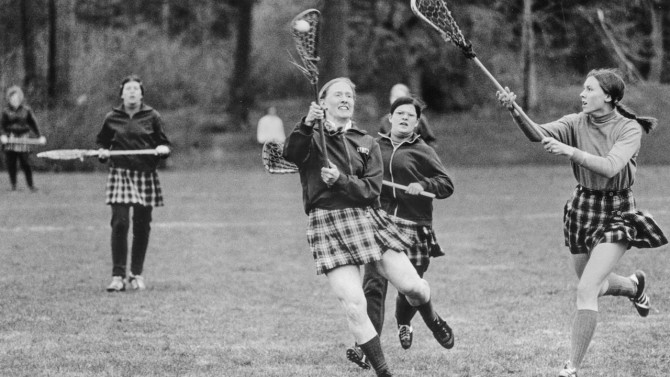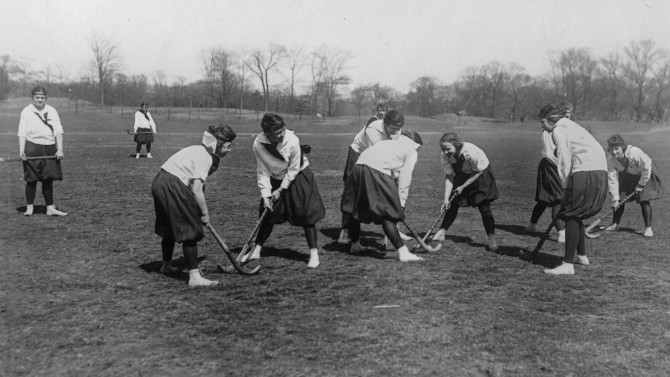
Before the Title IX legislation passed in 1972, women’s athletics at Cornell consisted of primarily interclass competition as part of physical education classes — like this women's baseball game in 1924. Throughout the 2021-22 seasons, Cornell Athletics will be celebrating the 50-year anniversary of women’s varsity athletics.
Cornell celebrates 50 years of women’s athletics
On June 23, 1972, President Richard M. Nixon signed into law Title IX, part of the Education Amendments to the U.S. Constitution, which prohibited sex-based discrimination in any school or other education program that received federal funding.
One of its most notable effects was on athletics: Women’s participation in sports grew exponentially, including at Cornell, which by the fall of 1972 had more than 300 women in a dozen intercollegiate sports – more than any other college or university in the state of New York.
But passage of Title IX was far from the beginning of women’s athletics on East Hill. From two-time national fencing champion Elizabeth Ross, Class of 1930, to triathlon Olympic and World Championship Series medalist Taylor Knibb ’20, women have a long history of athletic accomplishment at Cornell.
All this academic year, Cornell Athletics is celebrating 50 years of women’s varsity sports, shining a spotlight on Big Red pioneers, great moments and alumnae whose experience in sports helped propel them to success after graduation and paved the way for future women athletes.
This story is adapted from the book, “Silver Era, Golden Moments: A Celebration of Ivy League Women’s Athletics,” written by Paula D. Welch, historian and professor emerita at the University of Florida, to coincide with the 25th anniversary of Title IX in 1997:
Early days
As a long-time coeducational institution, Cornell has a storied history of women’s athletics, though before the 1970s sports were administered largely as an extension of physical education courses.
Women at Cornell engaged in basketball and rowing as early as 1897, with interclass competitions held in those sports by 1900; the addition of rowing also brought the arrival of Ellen Canfield, Cornell’s first woman physical training instructor. Field hockey was added soon after the turn of the century, and fencing was also offered early in the women’s athletics program’s development.
In 1930, the fencing team won the National Intercollegiate Women’s Fencing Association championship by defeating the defending champions from New York University. Cornell’s Elizabeth Ross won the individual fencing title in 1930 and ’31, as did Grace Acel in 1942 and ’43.
Cornell’s riflery and archery teams held telegraphic competitions in the 1930s – teams would compete at their own institutions, and compare results over telegraph – and interclass athletic events, intramural competitions between residence halls, and play days and sports days also were popular. Dorothy Bateman was director of women’s physical education from her arrival in 1920 until she retired and was succeeded by Martha Arnett in 1960.
The 1970s
By the early 1970s, Helen Newman Hall, a building originally used for recreational and instructional activities, had been transformed into a multipurpose facility for women’s intercollegiate sports. And by the fall of 1972, more than 300 women were representing Cornell in a dozen intercollegiate sports – more than any other college or university in the state of New York.
With the growth of interest in women’s athletics in the 1970s, Arnett identified the shortage of qualified women’s coaches and inadequate budgets as the primary detriments to further development of the program. The $19,000 allocated for women’s athletics came from the women’s physical education budget, while the men’s athletic program had an independent budget of $500,000.
Throughout the 1970s, Arnett continued to push for more support for women’s athletics, emphasizing the increased time commitment required of teacher-coaches when the number of students, level of competition and frequency of travel kept increasing. Finally, the university allocated $5,000 for new programs for the 1976-77 academic year, and authorized hiring a trainer to work with women athletes.
But even that was not sufficient to raise Cornell to where Arnett felt the program should be to compete with its peers, nor was it sufficient to meet the new Title IX mandates. In her 1976-77 annual report, Arnett cited requirements still not being met in the areas of coaching, facilities, funds for travel and equipment, sports information and fundraising. Arnett summarized her continuing frustration: “Cornell, a few years ago, had one of the best athletic programs for women in the country, but we are rapidly falling further and further behind both New York and Ivy schools.”
Despite the challenges of the decade, Cornell’s women athletes experienced success at the state, League, national, and even international level. The undefeated 1974 tennis team, for example, led by Helen Johnson, Sarah Reynolds, and Karen Krinsky, won New York State’s fall championship. Cornell ice hockey teams dominated the Ivy League in the 1970s, winning the first Ivy title in 1976 and five additional titles from 1977 through 1981. The 1978 gymnasts, including five freshmen, won the Ivy League championship and finished second in the New York State AIAW meet.
At the national level, Cornell continued its dominance in fencing, winning consecutive titles at the 1972 and 1973 NIWFA championships. And swimmer Hilary Walsh competed internationally in March 1975 when, at an official United States-Soviet Union meet in Leningrad, she won the 200-meter individual medley, finished second in the 400-meter individual medley, and third in the 200-meter butterfly event.
The 1980s
Teams in several sports had significant accomplishments at the school, league and national levels.
The decade began with a fifth straight Ivy League title in ice hockey in 1980 and a share of the 1981 title. At one point during the 1981 season, the team was ranked third in the country. The gymnastics team also reached the top of Ivy League competition, winning the championship in 1982, ’85, and ’88.
In 1984, the tennis team won its first tournament with the fall New York State Championship, and continued on to its first undefeated fall season, with Jana Klein and Linda Monastyer finishing undefeated in singles competition.
Two years later, the cross country team won more dual meets than any team in the history of the program. Finally, near the end of the decade, the crew ended its 1989 season by winning its first National Collegiate Women’s Rowing Championship, in the regatta on Lake Wingra at the University of Wisconsin, Madison. Rower Stephanie Maxwell, a member of the championship crew, had also competed in the 1988 Seoul Olympic Games.
Cornell elevated its soccer program to varsity status in 1982 under head coach Randy May. Three-time All-American Laurie Collier led the soccer team to an overall record of 35-14-8 in her three-year career and a share of the 1987 Ivy title. Voted Player of the Year in 1986, Collier was a first-team All-Ivy pick as well as an All-Northeast selection for three consecutive years. She set Cornell season and career records for goals, assists and points, and established school and Ivy single-game marks for points and goals scored.
The 1990s
The 1990s brought Cornell’s women athletes new successes with the elevation of softball to varsity status and the first Ivy League titles in such sports as field hockey, soccer, softball, and volleyball. In the latter part of the decade, several notable gifts to the program made possible the construction of important new facilities, including the Kane Sports Complex (soccer, lacrosse, track and field) and Niemand*Robison Field (softball).
In addition to new facilities, the decade was marked by notable team and individual athletic accomplishments. Under long-time coach May, the 1991 soccer team shared the Ivy League title with Dartmouth. In 1994. Cornell used a 2-0 win against No. 4 Hartford to achieve a national ranking of 14th and a number-one seed in the ECAC tournament, in which Cornell advanced to the final for the first time. The team marked its sixth straight appearance in the ECAC tournament in 1995, reaching the final for the second year in a row.
The volleyball team won its first Ivy League tournament in 1991 and followed up that victory with championships in 1992 and ’93, the latter of which led to an automatic bid to the NCAA tournament, the first participation of any Ivy League volleyball team in the NCAA postseason. Also winning Ivy titles during the decade was the field hockey program in 1991 and the ice hockey team, coached by former Harvard standout Julie Sasner, in 1996.
After having won the National Collegiate Rowing Association (NCRA) championship in 1989, the 1990 crew finished second at the Eastern Sprints and third at the national championships. In 1992, the crew finished second at the NCRA championship, and in 1994, it finished third at the Sprints and at the nationals.
Cornell’s Olympic athletes during this period included handball player Keri Farley and rower Andrea Thies, both of whom competed in the 1996 Summer Olympics in Atlanta. Thies has served as an assistant rowing coach at Princeton since 1998.
Read the full version of this story on the Cornell Athletics website.
Media Contact
Get Cornell news delivered right to your inbox.
Subscribe





